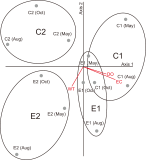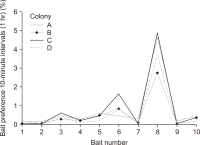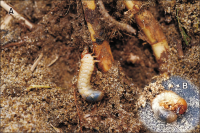
Vol.4 No.3

Abstract
This study aimed to identify the initial migratory macroinvertebrate species in two newly created mountain wetlands. To analyze the initial immigration species of macroinvertebrates, two experimental sites and two control sites were selected after habitat creation and investigated thrice from spring to fall. Benthic macroinvertebrates were collected quantitatively from each site using a Surber sampler and Modified D-frame deep net. After restoration at the two experimental sites, the number of macroinvertebrate species and individuals gradually increased from spring to fall and continued to increase over time with the development of waterside vegetation and habitat stabilization at the experimental sites. The species initially introduced to mountain wetlands after their creation were Ephemera strigata, Ephemera orientalis, Chironomidae sp., and Aquaris paludum. Subsequently, predators such as Davidius lunatus, Sieboldius albardae, Oyamia nigribasis, and Sialis longidens were introduced. Additionally, as a differentiating physicochemical factor between the two habitats, current velocity, which determines the distribution characteristics of benthic macroinvertebrates, and water temperature, which impacts the growth of organisms, showed a relatively stronger influence.








Abstract
In this study, the distribution, bait preference, hosts, symbionts, habitat status, and cytochrome c oxidase subunit-I sequences of the ant Linepithema humile were analyzed. This species habitat comprised approximately 1.5 km along stone crevices, flower gardens, roadsides, and container yards in the vicinity of Busan station, Korea. Feeding activity of this species was confirmed in 9 species of 7 families of plants. Which was approximately 14% of total flora (63 species of 37 families) in the studied area. Particularly, it was observed that Dendranthema indicum and Camellia japonica were the most frequently visited. Further, we verified that they interacted with four species of aphids. We identified 22 species of ants (17 genera, 4 subfamilies) inhabiting the Busan station area, including L. humile, Tetramorium tsushimae, Nylanderia flavipes and the alien species Paratrechina longicornis. In areas where L. humile was the dominant species, the habitat of local native ants was reduced by approximately 30%. Bait preference was ranked in the following order: jelly, water with glucose (25%), and yogurt, with the highest preference for baits containing sugar and protein. The 630-bp cytochrome c oxidase subunit-I sequences of the local L. humile populations were 99% identical to those of L. humile in the National Center for Biotechnology Information database, and the Argentine ants that invaded Korea had a sequence identical to that of other invasive populations from China, Japan, and New Zealand. As L. humile rapidly increases due to domestic adaptation, continuous monitoring and control strategy for eradication are needed to protect domestic biodiversity.









Abstract
Understanding the carrying capacity of a habitat is crucial for effectively managing populations of wild boars (Sus scrofa), which are designated as harmful wild animal species in national parks. Carrying capacity refers to the maximum population size supported by a park's environmental conditions. This study aimed to estimate the appropriate wild boar population size by integrating population characteristics and habitat suitability for wild boars in the Bukhansan National Park using the HexSim program. Population characteristics included age, survival, reproduction, and movement. Habitat suitability, which reflects prospecting and resource acquisition, was determined using the Maximum Entropy model. This study found that the optimal population size for wild boar ranged from 217 to 254 individuals. The population size varied depending on the amount of resources available within the home range, indicating fewer individuals in a larger home range. The estimated wild boar population size was 217 individuals for the minimum amount of resources (50% minimum convex polygon [MCP] home range), 225 individuals for the average amount of resources (95% MCP home range), and 254 individuals for the maximum amount of resources (100% MCP home range). The results of one-way analysis of variance revealed a significant difference in wild boar population size based on the amount of resources within the home range. These findings provide a basis for the development and implementation of effective management strategies for wild boar populations.






Abstract
One species of the genus Camponotus Mayr was newly recorded in South Korea. It was collected from Suhari, Subi-myeon, Yeongyang-gun and Gyeongsangbuk-do. Its corresponding descriptions, measurements and photographs were supplemented for the Camponotus yessensis Yasumatsu & Brown 1951.


Abstract
Polyphylla laticollis manchurica Semenov, 1900, is a critically endangered species in the Republic of Korea and is strictly protected as a Class I endangered species. Although this beetle species faces a threat of extinction, its ecological understanding is limited. Previous studies conducted on this species in the Republic of Korea have focused only on its taxonomy and mitochondrial genome sequences. Herein, we report an observation of the mating of adults of P. l. manchurica in June 2021, during an ongoing study on Korean beetles. This incidence was reported around light sources from newly constructed townhouses near Geumgang River. Larval habitats were observed along the river between April 2022 and March 2023. Particularly, two larvae were found inside the plant debris, and three were found under the roots of reeds. This study provides key information on the mating ecology of P. l. manchurica that can assist conservation efforts of this critically endangered species.





